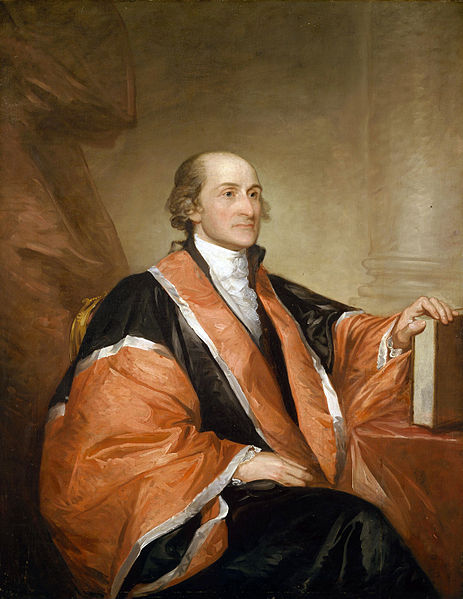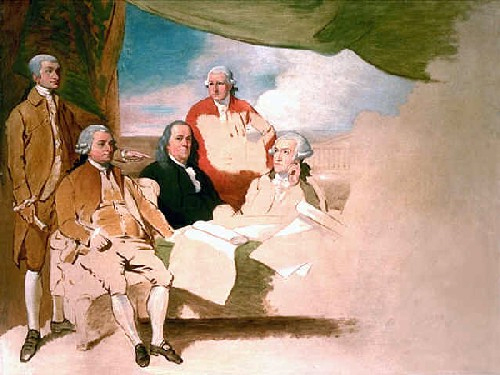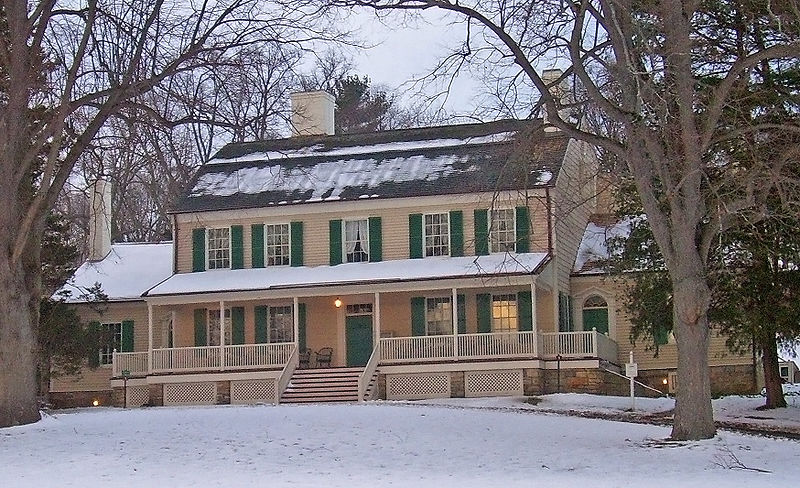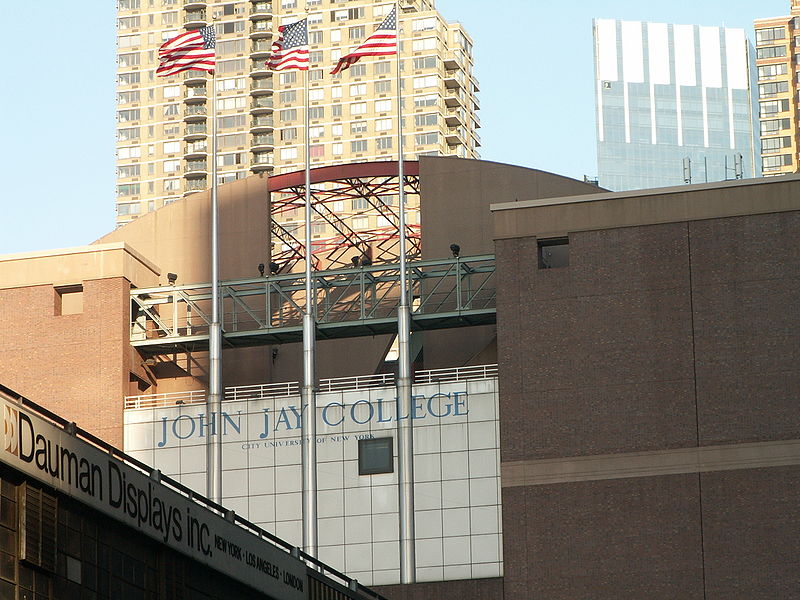<Back to Index>
- Anthropologist Eslanda "Essie" Goode Robeson, 1896
- Painter Karl Pavlovich Briullov, 1799
- President of the Continental Congress, Secretary of Foreign Affairs, Governor of New York and Chief Justice of the United States John Jay, 1745
PAGE SPONSOR


John Jay (December 12, 1745 – May 17, 1829) was an American politician, statesman, revolutionary, diplomat, a Founding Father of the United States, and the first Chief Justice of the United States (1789 – 95).
Jay served as the President of the Continental Congress from 1778 to 1779. During and after the American Revolution, Jay was a minister (ambassador) to Spain and France, helping to fashion United States foreign policy, and to secure favorable peace terms from Great Britain (with Jay's Treaty of 1794) and the First French Republic. Jay also co-wrote the Federalist Papers, along with Alexander Hamilton and James Madison. As a leader of the new Federalist Party, Jay was the Governor of New York State from 1795 to 1801, and he became the state's leading opponent of slavery. His first two attempts to pass laws for the emancipation of all slaves in New York failed in 1777 and in 1785, but his third attempt succeeded in 1799. The new law that he signed into existence brought about the emancipation of all slaves there before his death in 1829.
Jay was born on December 12, 1745, to a wealthy family of merchants in New York City. He was the eighth child and the sixth son in his family. The Jay family was of French Huguenot origin and was prominent in New York City. In 1685 the Edict of Nantes was revoked, thereby abolishing the rights of Protestants and confiscating their property. Among those affected was Jay's paternal grandfather, Augustus Jay, causing him to move from France to New York and to establish the Jay family there. Peter, Augustus's son and John's father, was a merchant and had ten children with his wife, Mary Van Cortlandt. Only seven of the ten children survived. After Jay was born, his family moved from Manhattan to Rye for a healthier environment; two of his siblings were blinded by the smallpox epidemic of 1739 and two suffered from mental handicaps.
Jay spent his childhood in
Rye, New York, and took the same political stand as his father, who was a staunch Whig. He was educated there by private tutors until he was eight years old, when he was sent to New Rochelle to
study under Anglican pastor Pierre Stoupe. In 1756, after three years,
he would return to home schooling under the tutelage of George Murray.
In 1760, Jay continued his studies at King's College, the then sixteen year old forerunner of Columbia University. In 1764 he graduated and became a law clerk for Benjamin Kissam.
His first public role came as secretary to the New York committee of correspondence, where he represented the conservative faction that was interested in protecting property rights and in preserving the rule of law while resisting what it regarded as British violations of American rights. This faction feared the prospect of "mob rule". He believed the British tax measures were wrong and thought Americans were morally and legally justified in resisting them, but as a delegate to the First Continental Congress in 1774 he sided with those who wanted conciliation with Parliament. Events such as the burning of Norfolk, Virginia, by British troops in January 1776 pushed Jay to support independence. With the outbreak of the American Revolutionary War, he worked tirelessly for the revolutionary cause and acted to suppress the Loyalists. Thus Jay evolved into first a moderate and then an ardent Patriot once he decided that all the colonies' efforts at reconciliation with Britain were fruitless and that the struggle for independence which became the American Revolution was inevitable.
Having
established a reputation as a reasonable moderate in New York, Jay was
elected to serve as delegate to the First and Second Continental Congresses which
debated whether the colonies should declare independence. He attempted
to reconcile the colonies with Britain, up until the Declaration of Independence.
Jay's views became more radical as events unfolded; he became an ardent
separatist and attempted to move New York towards that cause.
In 1774, at the close of the Continental Congress, Jay returned to New York. There he served on New York City's Committee of Sixty, where he attempted to enforce a non-importation agreement passed by the First Continental Congress. Jay was elected to the third New York Provincial Congress, where he drafted the Constitution of New York, 1777; his duties as a New York Congressman prevented him from voting on or signing the Declaration of Independence. Jay served on the committee to detect and defeat conspiracies, which monitored British Actions. New York's Provincial Congress elected Jay the Chief Justice of the New York Supreme Court on May 8, 1777, which he served on for two years.
The Continental Congress turned to Jay, an adversary of the previous president Henry Laurens,
only three days after Jay became a delegate and elected him President
of the Continental Congress. Eight states voted for Jay and four for
Laurens. Jay served as President of the Continental Congress from December 10, 1778, to September 28, 1779; he chaired the meetings but had little power.
On September 27, 1779, Jay was appointed Minister to Spain. His mission was to get financial aid, commercial treaties and recognition of American independence. The royal court of Spain refused to officially receive Jay as the Minister of the United States, as it refused to recognize American Independence until 1783, fearing that such recognition could spark revolution in their own colonies. Jay, however, convinced Spain to loan $170,000 to the US government. He departed Spain on May 20, 1782.
On June 23, 1782, Jay reached Paris, where negotiations to end the American Revolutionary War would take place. Benjamin Franklin was the most experienced diplomat of the group, and thus Jay wished to lodge near him, in order to learn from him. The United States agreed to negotiate with Britain separately, then with France. In July 1782, the Earl of Shelburne offered the Americans independence, but Jay rejected the offer on the grounds that it did not recognize American independence during the negotiations; Jay's dissent halted negotiations until the fall. The final treaty dictated that the United States would have Newfoundland fishing rights, Britain would acknowledge the United States as independent and would withdraw its troops in exchange for the United States ending the seizure of Loyalist property and honoring private debts. The treaty granted the United States independence, but left many border regions in dispute, and many of its provisions were not enforced.
Jay served as the second Secretary of Foreign Affairs from 1784 – 1789, when in September, Congress passed a law giving certain additional domestic responsibilities to the new Department and changing its name to the Department of State. Jay served as acting Secretary of State until March 22, 1790. Jay sought to establish a strong and durable American foreign policy: to seek the recognition of the young independent nation by powerful and established foreign European powers; to establish a stable American currency and credit supported at first by financial loans from European banks; to pay back America's creditors and to quickly pay off the country's heavy War debt; to secure the infant nation's territorial boundaries under the most advantageous terms possible and against possible incursions by the Indians, Spanish, the French and the English; to solve regional difficulties among the colonies themselves; to secure Newfoundland fishing rights; to establish a robust maritime trade for American goods with new economic trading partners; to protect American trading vessels against piracy; to preserve America's reputation at home and abroad; and to hold the country together politically under the fledgling Articles of Confederation.
Jay believed his responsibility was not matched by a commensurate level of authority, so he joined Alexander Hamilton and James Madison in advocating for a stronger government than the one dictated by the Articles of Confederation. He argued in his Address to the People of the State of New York, on the Subject of the Federal Constitution that the Articles of Confederation were too weak and ineffective a form of government. He contended that:
The Congress under the Articles of Confederation may make war, but are not empowered to raise men or money to carry it on — they may make peace, but without power to see the terms of it observed — they may form alliances, but without ability to comply with the stipulations on their part — they may enter into treaties of commerce, but without power to [e]nforce them at home or abroad... — In short, they may consult, and deliberate, and recommend, and make requisitions, and they who please may regard them.
Jay did not attend the
Constitutional Convention but
joined Hamilton and Madison in aggressively arguing in favor of the
creation of a new and more powerful, centralized but balanced system of
government. Writing under the shared pseudonym of "Publius," they articulated this vision in the Federalist Papers, a series of eighty-five articles written to persuade the citizenry to ratify the proposed Constitution of the United States. Jay
wrote the second, third, fourth, fifth and sixty-fourth articles. All
except the sixty-fourth concerned the "[d]angers from [f]oreign [f]orce
and [i]nfluence".
The Court's business through its first three years primarily involved the establishment of rules and procedure; reading of commissions and admission of attorneys to the bar; and the Justices' duties in "riding circuit," or presiding over cases in the circuit courts of the various federal judicial districts. No convention existed that precluded the involvement of Supreme Court Justices in political affairs, and Jay used his light workload as a Justice to freely participate in the business of Washington's administration. He used his circuit riding to spread word throughout the states of Washington's commitment to neutrality, then published reports of French minister Edmond - Charles Genet's campaign to win American support for France. However, Jay also established an early precedent for the Court's independence in 1790, when Treasury Secretary Alexander Hamilton wrote to Jay requesting the Court's endorsement of legislation that would assume the debts of the states. Jay replied that the Court's business was restricted to ruling on the constitutionality of cases being tried before it and refused to allow it to take a position either for or against the legislation.
The Court heard only four cases during Jay's Chief Justiceship. Its first case did not occur until early in the Court's third term, with West v. Barnes (1791). The Court had an early opportunity to establish the principle of judicial review in the United States with the case, which involved a Rhode Island state statute permitting the lodging of a debt payment in paper currency. Instead of grappling with the constitutionality of the law, however, the Court unanimously decided the case on procedural grounds, strictly interpreting statutory requirements.
In Chisholm v. Georgia, the Jay Court had to answer the question: "Was the state of Georgia subject to the jurisdiction of the Supreme Court and the federal government?" In a 4 - 1 ruling (Iredell dissented), the Jay Court ruled in favor of two South Carolinan Loyalists who had had their land seized by Georgia. This ruling sparked debate, as it implied that old debts must be paid to Loyalists. The ruling was overturned by the Senate when the Eleventh Amendment was ratified, as it ruled that the judiciary could not rule on cases where a state was being sued by a citizen of another state or foreign country. The case was brought again to the Supreme Court in Georgia v. Brailsford, and the Court reversed its decision. However, Jay's original Chisholm decision established that states were subject to judicial review.
In Hayburn's Case, the Jay Court ruled that courts could not comply with a federal statute that required the courts to decide whether individual petitioning American Revolution veterans qualified for pensions. The Jay Court ruled that determining whether petitioners qualified was an "act ... not of a judicial nature," and that because the statute allowed the legislature and the executive branch to revise the court's ruling, the statute violated the separation of powers as dictated by the United States Constitution.
In Georgia v. Brailsford (1794), the Court upheld jury instructions stating "you [jurors] have ... a right to take upon yourselves to ... determine the law as well as the fact in controversy." Jay noted for the jury the "good old rule, that on questions of fact, it is the province of the jury, on questions of law, it is the province of the court to decide," but this amounted to no more than a presumption that the judges were correct about the law. Ultimately, "both objects [the law and the facts] are lawfully within your power of decision."
In 1792, Jay was the
Federalist candidate for governor of New York, but he was defeated by Democratic - Republican George Clinton. Jay received more votes than George Clinton; but, on technicalities, the votes of Otsego, Tioga and Clinton counties were disqualified and, therefore, not counted, giving George Clinton a slight plurality. The State constitution said that the cast votes shall be delivered to the secretary of state "by
the sheriff or his deputy"; but, for example, the Otsego County
Sheriff's term had expired, so that legally, at the time of the
election, the office of Sheriff was vacant and the votes could not be
brought to the State capital. Clinton partisans in the State
legislature, the State courts, and Federal offices were determined not
to accept any argument that this would, in practice, violate the
constitutional right to vote of the voters in these counties.
Consequently, these votes were disqualified.
The treaty did not resolve American grievances about neutral shipping rights and impressment, and the Republicans denounced it, but Jay, as Chief Justice, decided not to take part in the debates. The failure to get compensation for slaves taken by the British during the Revolution "was a major reason for the bitter Southern opposition". Jefferson and Madison, fearing a commercial alliance with aristocratic Britain might undercut republicanism, led the opposition. Jay complained he could travel from Boston to Philadelphia solely by the light of his burning effigies. However, led by Hamilton's newly created Federalist party and support from Washington, strongly backed Jay and thus won the battle of public opinion. Washington put his prestige on the line behind the treaty and Hamilton and the Federalists mobilized public opinion. The Senate ratified the treaty by a 20 - 10 vote (just enough to meet the 2/3 requirement.) Graffiti appeared near Jay's house after the treaty's ratification, reading, "Damn John Jay. Damn everyone that won't damn John Jay. Damn everyone that won't put up the lights in the windows and sit up all nights damning John Jay."
In 1812, relations between Britain and the U.S. faltered. The desire of a group of members in the House of Representatives, known as the War Hawks, to acquire land from Canada and the British impressment of American ships led, in part, to the War of 1812.
While in Britain, Jay was elected in May, 1795, as the second governor of New York State (following George Clinton) as a Federalist. He resigned from the Supreme Court service on June 29, 1795, and served six years as governor until 1801.
As Governor, he received a proposal from Hamilton to gerrymander New York for the Presidential election of that year; he marked the letter "Proposing a measure for party purposes which it would not become me to adopt," and filed it without replying. President John Adams then renominated him to the Supreme Court; the Senate quickly confirmed him, but he declined, citing his own poor health and the court's lack of "the energy, weight and dignity which are essential to its affording due support to the national government."
While governor, Jay ran in the 1796 presidential election, winning five electoral votes, and in the 1800 election, winning one vote.
Jay declined the Federalist renomination for governor in 1801 and retired to the life of a farmer in Westchester County, New York. Soon after his retirement, his wife died. Jay remained in good health, continued to farm and stayed out of politics.
On the night of May 14, 1829, Jay was stricken with palsy, probably caused by a stroke. He lived for three days, dying in Bedford, New York, on May 17. Jay had chosen to be buried in Rye, where he lived as a boy. In 1807, he had transferred the remains of his ancestors from the family vault in the Bowery in Manhattan to Rye, establishing a private cemetery. Today, the Jay Cemetery is an integral part of the Boston Post Road Historic District, adjacent to the historic Jay Property. The Cemetery is maintained by the Jay descendants and closed to the public. It is the oldest active cemetery associated with a figure from the American Revolution.
The original Jay family estate, overlooking Long Island Sound, was first established in Rye in 1745 when Jay was three months old. It passed into John Jay's possession in 1815; and he conveyed it to his eldest son, Peter Augustus Jay, in 1822. The property remained in the Jay family through 1904. What remains of the original 400 acre (1.6 km2) estate is a 23 acre (93,000 m2) parcel called the Jay Property and the 1838 Peter Augustus Jay House built by Peter Augustus Jay over the footprint of his father's original home "The Locusts." Stewardship of the site and restoration of several of its buildings for educational use was entrusted by the New York State Board of Regents to the Jay Heritage Center.
Jay was a leader against slavery after 1777, when he drafted a state law to abolish slavery; it failed as did a second attempt in 1785. Jay was the founder and president of the New York Manumission Society, in 1785, which organized boycotts against newspapers and merchants in the slave trade and provided legal counsel for free blacks claimed as slaves. The Society helped enact the gradual emancipation of slaves in New York in 1799, which Jay signed into law as governor.
Jay was pushing at an open door; every member of the New York legislature (but one) had voted for some form of emancipation in 1785; they had differed on what rights to give the free blacks afterwards. Aaron Burr both supported this bill and introduced an amendment calling for immediate abolition. The 1799 bill settled the matter by guaranteeing no rights at all. The 1799 "An Act for the Gradual Abolition of Slavery" provided that, from July 4 of that year, all children born to slave parents would be free (subject only to apprenticeship) and that slave exports would be prohibited. These same children would be required to serve the mother’s owner until age twenty-eight for males and age twenty-five for females. The law thus defined a type of indentured servant while slating them for eventual freedom. All slaves were emancipated by July 4, 1827; the process may perhaps have been the largest emancipation in North America before 1861, except for the British Army's recruitment of runaway slaves during the American Revolution.
In the close 1792 election, Jay's antislavery work hurt his election chances in upstate New York Dutch areas, where slavery was still practiced. In 1794, in the process of negotiating the Jay Treaty with the British, Jay angered Southern slave owners when he dropped their demands for compensation for slaves who had been captured and carried away during the Revolution. He made a practice of buying slaves and then freeing them when they were adults and he judged their labors had been a reasonable return on their price; he owned eight in 1798, the year before the emancipation act was passed.
Jay was Anglican, a denomination renamed the Protestant Episcopal Church in America after the American Revolution. Since 1785 Jay had been a warden of Trinity Church, New York. As Congress's Secretary for Foreign Affairs, he supported the proposal after the Revolution that the Archbishop of Canterbury approve the ordination of bishops for the Episcopal Church in the United States. He argued unsuccessfully in the provincial convention for a prohibition against Catholics holding office.
In a letter addressed to Pennsylvania House of Representatives member John Murray, dated October 12, 1816, Jay wrote, "Providence has given to our people the choice of their rulers, and it is the duty, as well as the privilege and interest, of our Christian nation to select and prefer Christians for their rulers."
Several geographical locations have adopted John Jay's name, including: Jay, Maine; Jay, New York; Jay, Vermont; Jay County, Indiana and Jay Street in Brooklyn. In 1964, the City University of New York's College of Police Science was officially renamed the John Jay College of Criminal Justice. The colonial Fort Jay on Governors Island is also named for him. Mount John Jay, also known as Boundary Peak 18, a summit on the border between Alaska and British Columbia, Canada, is also named for him, as is Jay Peak, in northern Vermont.
On December 12, 1958, the United States Postal Service released a 15¢ Liberty Issue postage stamp honoring Jay.
There are also high schools named after Jay located in Cross River, New York; Hopewell Junction, New York, and San Antonio, Texas. The Best Western Hotel chain named several of their colonial motif hotels the John Jay Inn.
Exceptional undergraduates at Columbia University are designated John Jay Scholars, and one of that university's undergraduate dormitories is known as John Jay Hall. The John Jay Center on the campus of Robert Morris University and the John Jay Institute for Faith, Society & Law are also named for him. Jay's house, located near Katonah, New York, is preserved as a National Historic Landmark and as the John Jay Homestead State Historic Site.

